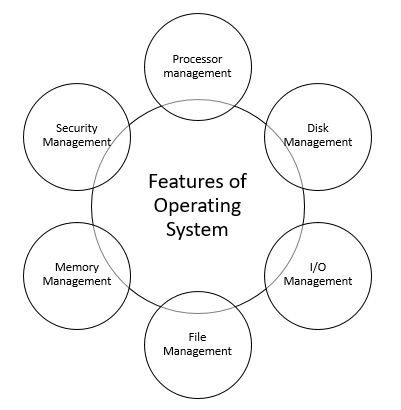
 Data Structure
Data Structure Networking
Networking RDBMS
RDBMS Operating System
Operating System Java
Java MS Excel
MS Excel iOS
iOS HTML
HTML CSS
CSS Android
Android Python
Python C Programming
C Programming C++
C++ C#
C# MongoDB
MongoDB MySQL
MySQL Javascript
Javascript PHP
PHP
- Selected Reading
- UPSC IAS Exams Notes
- Developer's Best Practices
- Questions and Answers
- Effective Resume Writing
- HR Interview Questions
- Computer Glossary
- Who is Who
What are the features of Operating Systems?
The features of operating systems are increasing day by day. Because at the starting development of the OS it was used to handle storage taps but now it is working on GUI by throwing brilliant colours.
Given below are the features of the operating system −
Memory Management
The operating system controls the primary memory or main memory.
Primary memory is a large array of bytes or words where each byte or word is assigned a certain address.
It is a fast storage, and it can be accessed directly by the CPU which is present inside the system. If a program wants to be executed, it should be first loaded in the main memory.
The following activities are performed by operating system for memory management −
It keeps track of primary memory.
Memory addresses that have already been allocated and the memory addresses of the memory that has not yet been used.
In multiprogramming, the OS decides for how long the process must stay and the order in which processes are granted access to memory.
It allocates the memory to a process when the process requests it and deallocates the memory when the process has terminated.
Processor Management
The OS manages the order in which processes have access to the processor, and how much processing time that each process must stay in the multiprogramming environment. This is called process scheduling.
The following activities are performed by operating system for processor management −
Keep tracks of the status of processes.
The program to track the status is known as traffic controller.
It allocates the CPU.
And de-allocates the processor when it is not required.
Device Management
An OS manages device communication through respective drivers.
The following activities are performed by operating system for device management −
Keeping track of all devices connected to the system.
Designates a program that is responsible for every device called the Input/output controller.
It decides which process gets access to a device and for how long and allocates devices in an effective and efficient way.
And de-allocates devices when they are not required.
File Management
Operating system also keeps track of the file system of a computer normally the file system is divided in directories which can be handled by the OS.
I/O Management
I/O management is one of the important tasks of the operating system. OS manages the IO devices like mouse, keyboard, printer, display, LED's etc.
I/O devices can be of two types −
Synchronous I/O − Here, CPU waits for the I/O device
Asynchronous I/O − Here, the CPU execution takes place parallel to the IO device.
The operating system helps the processor in communicating to the IO devices. These communications are Special instruction I/O, Memory mapped I/O, Direct memory access.
Security Management
The confidential data stored in the system is protected by the operating system and does not allow the unauthorised person to access the system. It helps the system from malware attack and it acts as supervisor mode and gives the system a strongly protected firewall.
The figure given below shows the features of operating systems −


